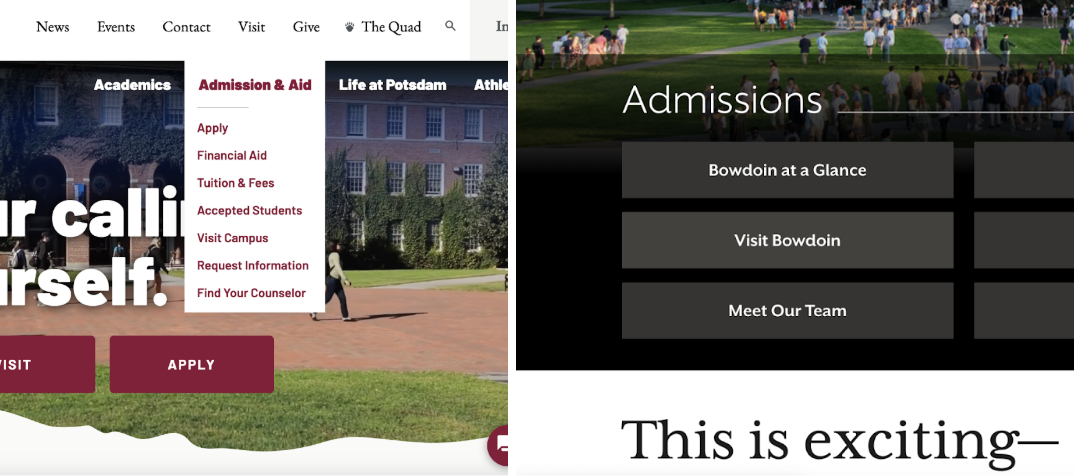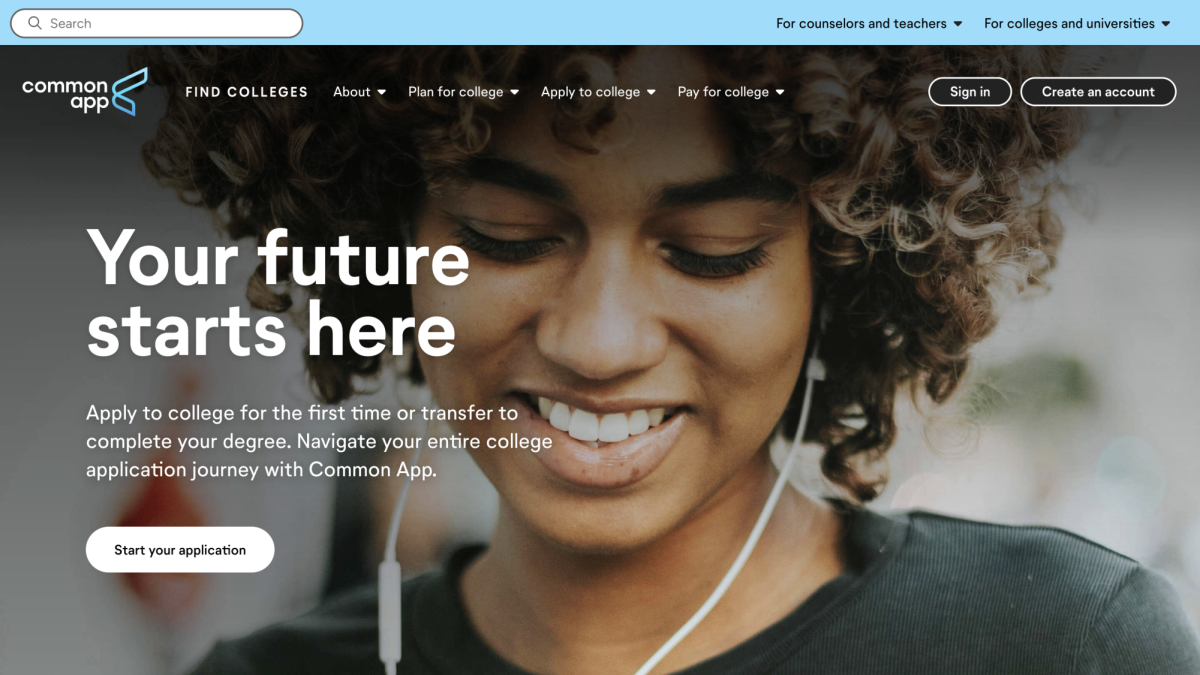Senior year: a year of closure – breakfasts, sunrises and sunsets, walk-throughs, throwing one’s cap in the air, but also a year of beginnings. The monumental characteristic of senior year is the college application process, starting at the end of junior year with SATs, recommendation letter requests, and college tours. Aside from those who choose to go to trade school, join the military, take a gap year, or directly enter the workforce, the process is a shared experience between the majority of the grade. And yet, most of the information about the process is still primarily shared in the guidance office. So what does this process entail, and what wisdom do our Class of 2025 seniors have to bestow?
Choosing Your Schools
Before the application process ever begins, you have to decide what schools you’re interested in. This process can be tedious, combing through the over 5,000 campuses available in the United States alone. Some factors to consider are location (continent, country, urban vs. rural, geographic setting, etc.), size (student to teacher ratio), gendered vs. coed, offered majors, special opportunities (such as studying abroad), and what sports/student groups they have available. This is a lot to keep in mind, so it’s recommended you organize your list in a table where you can compare these different aspects of your schools.
Safety, Match, and Reach
One system that many students use to determine the schools they apply to is defining schools as safety, match, or reach. Once you have a list of schools you are interested in, this organizational tool helps identify where you’d lie in the admissions process based on your grades and standardized test scores. Even though many schools no longer require standardized test scores, it’s still a good statistic to look at in order to get a sense of the grades of students they have admitted before (as a note: you should only look at these numbers for the past year of admissions, since criteria for tests and curriculums change all the time).
Out of the recommended minimum of six schools, at least one should be safety, two should be match, and three should be reach (Big Future). As you expand your list, you can have any variation from those numbers you wish. The way to determine which a school is for you is the following guide from Big Future:
If your GPA and standardized test scores (SAT and/or ACT) are higher than the average of that of the most recently accepted students, the school is a safety.
If your GPA and test scores fall in the same range as the average, the school is a match.
If your GPA and scores are below the average, the school is a reach. That doesn’t mean you should be discouraged though! It’s just an average, and other aspects of your application such as extracurriculars and community service can still make you stand out.
College Tours
The next staple in the college search is taking tours. To get on the list from these, you can either respond to an email regarding it you get from the school (if you checked the little box saying you were interested when you take the PSAT, SAT, or an AP exam), or, you can go on their website. On most websites, there will be a “Visit (insert college name here)” sub tab under either the Admissions or Visit main tab.

Tours can be either virtual or in person. If the school you’re interested in is too far away to commit to traveling when you haven’t been accepted, or if you don’t have the time to go, then virtual tours are a completely viable option. It’s important to do something though, since this lets schools know you’re interested.
Tours can also be the deciding factor of whether you want to go to a school, even if it looks good on paper. Sarah Coggeshall explained that when he toured, he,“look[ed] around to see if people [were] actually happy to be there. Because there were some schools where they were not happy to be there, and it felt like high school where it’s like ‘We’re gonna get through this! Only three years left to go!’ and that’s not where I want to end up, I want to end up at a school where people are happy to be there and they like the school and they like the programs.”
When you’re on your tour, there are a lot of things you can look out for and ask about. It’s important you interact to get as much information as possible and to once again continue to show interest. The following list can serve as a starting point in order to determine what you want to ask, specific to the school and yourself:
- What is the food like on campus? (If they say something along the lines of “Well you know, you eat the same food everyday so you’re probably going to get sick of it,” chances are the food’s not great.)
- What’s the parking situation like? What year can you park a car on campus?
- How difficult is it to schedule classes? Do you usually get the classes you want?
- What are mental health support options like?
As a general rule of thumb, as Shea Gallagher explained, you want to, “ask them [specific questions] because you can find everything else online.”
Recommendation Letters
Choosing Who to Ask
Once you have a number of schools you’re interested in, you need to secure some recommendation letters. A recommendation letter should reflect who you are as a student and community member. The number of recommendations required differs a bit per school, but you usually need at least one academic recommendation (this requirement can be found on the school’s website). When choosing who to request a letter from, think about the classes, sports, or extracurriculars you felt you’ve done your best work in.
Asking for a Letter
The next step is actually asking. Our high school has the convenient opportunity for juniors to be able to go around and ask their teachers. While you should have high school teachers for however many academic recommendations the school requires, you can ask middle school teachers or an outside source who you feel truly knows you, too! You should only ask those who you’ve continued to work with, not just someone who knew you as a student 4-6 years ago, but it can be a great asset.
When you ask for a letter of recommendation, for college and throughout your life, you have to be sure to ask the person with enough warning. It is completely within their right to say no if you don’t give them enough time, and if you don’t have a back up plan, you could either have to ask someone who wouldn’t be able to write you a letter that truly reflects who you are or, in the worst case scenario, end up with no letter at all.
The Application Process
The Essay(s)
After you have your schools, have requested recommendations, and have signed into a service such as the Common Application (which your guidance counselor will help you set up at the end of the year, you should check in with them if for some reason they don’t), the next step is preparing to write your essay(s). Your essays showcase who you are as a person aside from who you are on paper with grades, extracurriculars, and community service, and allow you to stand apart from your fellow applicants.
Though writing an essay might feel daunting, it can be an exciting process, and inspiration for it can strike anywhere. Coggeshall shared that he got the idea for one of his essays in the middle of the movie theater: “I had to remember my idea through the rest of the movie!” And besides, they usually only have to be around 650 words – much shorter than that six-page English essay you’ve had to write! You don’t have to be a world-class writer in order to write a great essay; you just need to be yourself. The following advice from Harvard Summer School’s blog is super helpful as you plan your essay out:
- Be authentic – Readers at the collegiate level can tell when you’re not being genuine, so be yourself! Especially because this is your one opportunity to really do that.
- Grab the reader from the start – Get the reader’s attention with a strong hook (which can be more than one sentence) in order to draw them in; as a bonus it also can help you get farther with your writing!
- Focus on deeper themes – Write about you, not just what you’ve done.
- Show, don’t tell – Use descriptive language to help the reader completely understand the picture you’re painting; don’t just tell them and move on.
- Try something different – Come in from a unique perspective to stand out from the crowd.
- Write with the reader in mind – Make sure what you’ve written makes sense to someone not inside of your head, regarding information and organization.
- Write several drafts – Writing a draft then coming back a few days later with fresh eyes can help you revise.
- Read it aloud – Vocalizing what you’ve written can help you determine what needs to be edited.
- Don’t repeat – Don’t repeat what you’ve already included in other parts of your application; you want to include something they don’t already know about you.
- Ask others to read your essay – This can make your revision much more focused.
- Pay attention to form – Keep your essay within the recommended word limit (you might lose their attention if you go over) and make sure font, margins, and spacing looks clean.
- End your essay with a “kicker” – A punchy line, paragraph, or final section leaves a lasting impression!
Despite the pressure you may feel for your essays to be perfect, don’t wait to start it. Coggeshall and Zoe Ulrich both recommend you start working on it over the summer, which is convenient because that’s usually when new supplemental essay prompts come out (though you can start working on your personal one(s) prior to that). Moreover, having it fully written is enough; once you finish an essay your guidance counselor, and English teacher(s) are available to help you revise it to be the best it can be before submission.
Deadlines
One of the most important things to keep in mind throughout your college application process is deadlines.
You are going to have a number of deadlines on your plate, and they are going to come up at slightly different times due to different schools’ schedules, scholarship deadlines (more information on scholarships below) being separate from that track, and if you decide to apply early action (EA), early decision (ED), or regular decision (RD). As College Essay Advisors outlined, RD deadlines are usually January 1st, while ED and EA decision deadlines are typically somewhere around November 1st. Some schools do have rolling admissions as space is available, but that is generally used as a back-up.
Described on College Board’s website, the differences between RD, EA, and ED are pretty simple. RD applicants apply by around January and hear back anywhere from mid-March to early April (Ivy Coach). EA and ED basically guarantee hearing back sooner, which is great if there’s somewhere you really want to go: ED applicants hear back first, usually in December, but you can only apply to one school ED and upon agreeing to attend (after being accepted and if you’re offered a sufficient financial aid package) you have to withdraw all other applications. With EA applications on the other hand, you hear back around January or February and can apply to as many schools EA as you want.
Keeping all of this in mind, it’s important to find some way to keep track of all of your deadlines. A spreadsheet in Google Docs or in a service like Notion might help, along with adding them to your calendar with notifications on, or whatever you usually do to remember the important things in your life. It’s also key to be able to check them off when you’re done, as there’s nothing more satisfying than crossing-off items in a long to-do list!
Auditions
A separate aspect of the college application process for a number of students is auditioning for non-strictly academic schools or programs of their interest. For artists, this usually involves putting together a portfolio, and for musicians, this means auditioning in addition to regular applications. You can audition for voice or any instrument, and the processes are very similar.
As you begin, many schools require a pre-screen, a video recording you send in that showcases your skill. “The pre-screens sound scarier than they were, but for me it was just the deadlines,” shared Riona Hack.
After you hear back about your pre-screen, if you passed (and if you got in academically depending on the school; some make you wait and some don’t), you can then schedule an audition. “You go in, you do your stuff, and you leave. And I wouldn’t say that they were terrible, they were fun … because you met people that you are maybe gonna go to school with, so it was nice,” Hack commented. For your audition, you prepare at least one piece and should be prepared to sight read and/or do scales, especially the latter as an instrumentalist.
Gallagher recommends that you should start practicing for your audition “Now. Yesterday.” In preparation for your audition you can either work on your own, consult Mr. Conroy or Ms. Natalie, or work with a private teacher like he ended up doing. “She was like ‘you need to do some serious work,’ so then I started practicing like five hours a day for like a year.”
No matter what, Hack reminds you to not take any criticism or rejection personally. She assures, “you’re going to end up where you belong.”
Financial Aid
As you go through the process, there are going to be a lot of big price tags that will come across your screen. This shouldn’t immediately scare you off though, there are a lot of financial aid opportunities out there, and that’s something else you have to keep in mind while you apply to your schools. While schools will provide you with a financial aid package once you get in, it’s important to double down on aid by applying to the FAFSA (which will let you know your eligibility for grants, scholarships, and loans) and to scholarships.
The FAFSA, or “Free Application for Federal Student Aid,” is a 30-minute application which determines how much financial aid you are eligible for; both need-based (need for financial assistance) and merit-based (i.e. grades, extracurriculars, sports, and community service). The application can be found at studentaid.gov, and the deadline is usually June 30th.
Another way to get financial aid is to get a scholarship. You can either be nominated for a scholarship or, what the case is for the majority of students, apply. There are need-based scholarships, merit-based scholarships, ones based on your major, the list goes on. Scholarships are available at the local, state, and national levels. Two great sources for scholarships are the Higher Education Services Corporation and our very own school website!
Deciding on Your School
At this point, you’ve done all you can, and now all you can do is wait. People starting to announce where they’re going and what they’re going to study can be a bit stressful if you haven’t heard back yet or haven’t decided where you’re going to go, but Ulrich reminds you to take a breath and that it’s okay to not have everything figured out. “People are going to be like ‘I’m going to this school’ and ‘I’m going to this school’ and you’re gonna feel behind, but you’re not behind … You have time to figure yourself out.”
Once you hear back, there are a variety of ways to decide where you want to go. If you only have the opportunity to tour (formally/informally) after you’ve been accepted, then that can help narrow it down, and you can also look at what the cost has ended up being. A good old fashioned pros and cons list also never hurts.
When it comes down to it, what matters the most is where you envision yourself being for the next four years of your life. You want to be somewhere where you can learn and grow, not be held down by a negative environment or bad course options.
You’re going to do great, just take everything one step at a time and do what you want to do. It’s okay to not know and it’s okay to change your mind because that’s life, and lots of people take a gap year or go to college with an undecided major. Just stay on top of it (Ulrich imparts, “if you’re someone who does not check their email often, you need to be checking your email”), and you’ll do wonderfully.
Oh, and Shea thinks that you should go practice.




